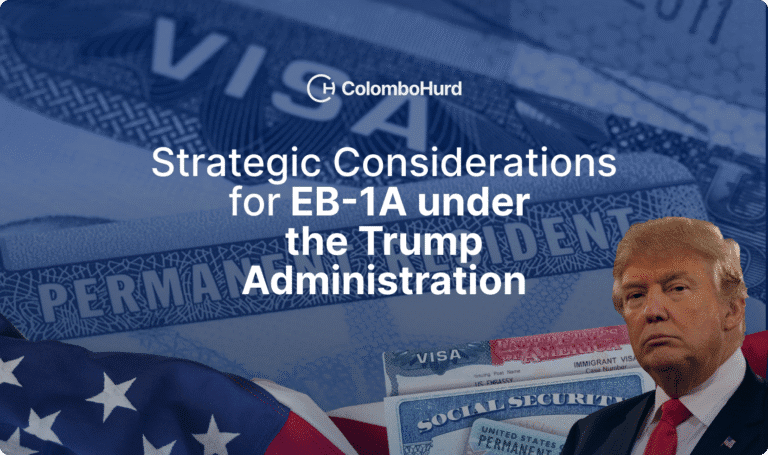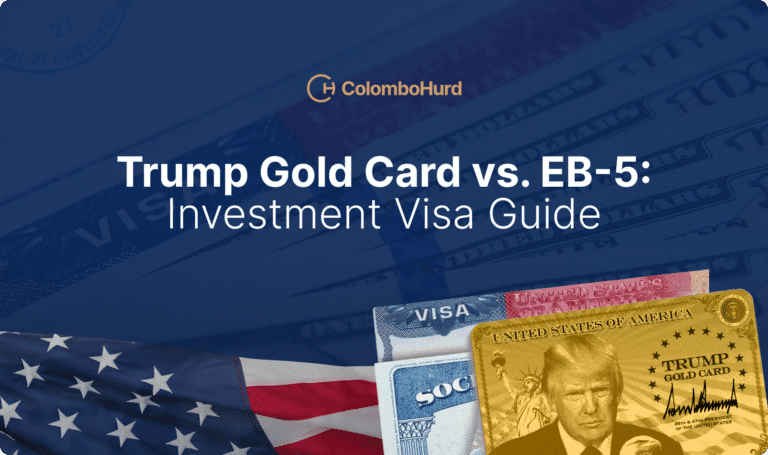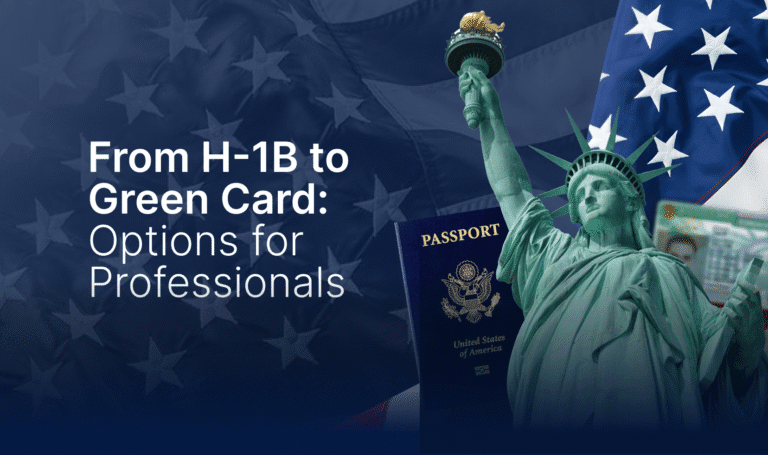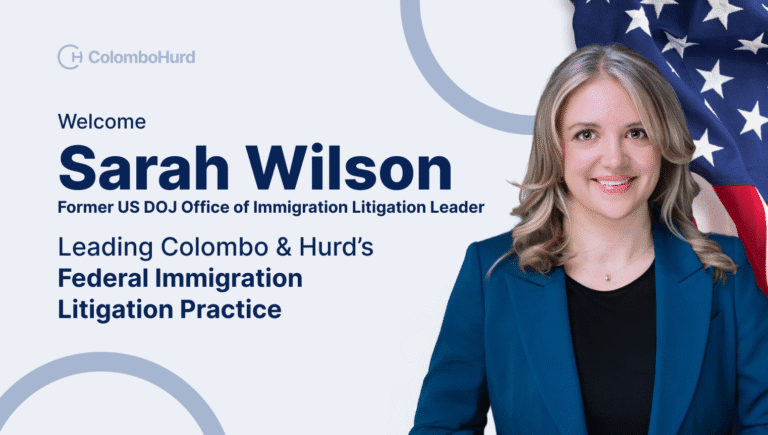The EB-1A visa offers a unique route to permanent residency for individuals recognized at the top of their profession. Recent policy changes under the Trump Administration have made it more important than ever to frame petitions with precision and strategy.
To help make sense of today’s evolving environment, four of our attorneys at Colombo & Hurd share their perspectives on the key considerations shaping EB-1A petitions under the Trump Administration.
Quality Over Quantity in Criteria Selection
Roshn Vazhel, RFE Department Director
“EB-1A continues to be one of the speediest pathways for permanent residency and its self-petitioned nature is a boon in today’s lengthening processing times.”
Mr. Vazhel emphasizes that the EB-1A remains one of the fastest ways to achieve permanent residency, especially as other visa categories face longer wait times. Its self-petitioned structure allows petitioners to move forward without depending on employer sponsorship, making it highly valuable in today’s environment.
“Under the new administration, there should be a heightened focus on quality, not quantity, for claimed criteria. While this has always been important, there is an increased temptation in current conditions to try and support criteria that are not clearly met by the petitioner in plain language to “strengthen” the petition. However, this can backfire as it can trigger unnecessary challenges and removes focus from the criteria that have been met in plain language and are in fact well supported, fundamentally weakening the petition.”
He warns that petitioners often undermine their cases by overreaching. Trying to force evidence into criteria that are not truly satisfied weakens the petition. Officers can easily identify weak claims, which risks drawing attention away from stronger evidence and triggering unnecessary Requests for Evidence. For Mr. Vazhel, the strongest EB-1A petitions are clear and focused. They highlight the criteria that are unmistakably met and present evidence in straightforward language, leaving no ambiguity for officers.
“An important thing to remember is that EB-1A is not a discretionary petition, and the criteria have been helpfully described in the policy manual appendices – which both you and the officer have full access to. Ensuring that your petition meets at least 3 of these criteria in a well supported and clearly articulated manner and can survive a final merits determination is the best pathway to success.”
Mr. Vazhel reminds petitioners that EB-1A adjudication is not discretionary. Officers and petitioners alike are guided by the policy manual appendices, which describe each criterion. The strongest petitions mirror this structure, ensuring that the officer can quickly see how the evidence satisfies the law.
His overall message: quality of evidence matters more than the number of criteria claimed. A leaner petition that demonstrates strength in three areas will fare better than a bloated one that attempts to cover six but struggles in most. This approach not only strengthens the petition but also helps it withstand a final merits determination, the stage where the officer must decide whether the overall record proves sustained acclaim.
High Salary and Compensation Criteria
Allison McVey, Immigration Attorney
“The EB-1A has long recognized high salary or remuneration, relative to others in the same field, as a strong indicator of extraordinary ability. If you earn more than the majority of professionals in your field, this can serve as compelling evidence of your exceptional standing. This does not just include base salary; bonuses, stock options, equity, and other financial rewards can also be included when demonstrating that your compensation sets you apart.”
Ms. McVey explains that high earnings continue to be one of the strongest forms of evidence for EB-1A eligibility. She stresses that petitioners should present the full picture of their compensation. In industries like finance, technology, and entrepreneurship, equity or stock options may carry more weight than base salary. In academia, grants or stipends might be relevant. Each field has its own benchmarks, and USCIS looks for evidence that the petitioner’s compensation is substantially above the norm for their profession.
“Traditionally, there’s been no single dollar amount that qualifies under this criterion. Instead, USCIS uses a comparative analysis to determine how your earnings stack up against others in your industry, role, and geographic region. For example, a salary considered exceptional in academia might look very different from what’s considered exceptional in business or technology. The key is demonstrating that your compensation is substantially above the norm for your profession.”
This comparative analysis means petitioners must provide context, such as salary surveys, industry reports, or expert testimony. A strong petition makes clear not only what the petitioner earns, but why those earnings are extraordinary in their specific professional environment.
Finally, Ms. McVey reminds petitioners that EB-1A does not require success in every possible category.
“It’s important to note that if a petitioner cannot show high salary or remuneration, that does not disqualify them from the EB-1A. There are 10 possible criteria we can consider for this visa category, and meeting at least three is enough to establish eligibility.”
The lesson from Ms. McVey’s perspective is that compensation evidence remains a powerful tool when supported by strong comparative data.
Multi-Track Immigration Strategies
Mandy Nease, Senior Immigration Attorney and Former USCIS Officer
“Consider the EB-1A I-140 as part of a multi-faceted immigration strategy. It is ok to have more than one I-140 in more than one preference class. Officers know that with job changes and visa regression that multiple I-140s will be filed.”
Ms. Nease advises petitioners to view the EB-1A as one part of a broader immigration plan rather than a stand-alone option. Based on her 13 years of adjudicating petitions at USCIS, she confirms that officers expect petitioners to pursue multiple filings, especially in times of visa retrogression and uncertain job markets.
Petitioners can file an EB-1A while also pursuing an EB-2 National Interest Waiver or an employer-sponsored EB-2 or EB-3 petition. At the same time, many maintain temporary status such as the O-1 visa. This multi-track approach ensures that if one petition faces delay or additional scrutiny, another can move forward.
Ms. Nease emphasizes that officers understand that petitioners and their families must protect themselves against changing circumstances. Having multiple I-140s filed is not seen as suspicious. Instead, it shows that petitioners are prepared for long timelines and are serious about securing permanent residency.
Her message is straightforward: a diversified strategy provides stability. Petitioners should treat the EB-1A as a powerful tool, but one that often works best when combined with other options to preserve flexibility and protect future opportunities.
Evidence Trends and Timing Considerations
Anthony S. DeLucia, Partner
“Under the Trump Administration, EB-1A petitions are likely to become more popular because the administration has been clear about wanting the best and brightest. That necessarily falls under EB-1A. Officers are likely to look on these petitions more favorably, but petitioners should expect increased processing times as demand grows.”
Mr. DeLucia believes EB-1A demand will grow under the Trump Administration as the U.S. places renewed emphasis on attracting highly skilled professionals. This increase will lead to longer processing times and more competition for visa numbers. In this environment, the strength and presentation of evidence becomes even more important.
He stresses that one of the most powerful criteria to claim is Original Contributions of Major Significance (OCMS), because it naturally supports the final merits determination. Petitioners who can show that their work is unique, has advanced their field, and has been recognized by peers have a strong foundation for EB-1A approval:
“Virtually every EB-1A petitioner should be claiming Original Contributions of Major Significance. It proves that your work is novel, original, and impactful, and that others in the field recognize its significance. That recognition makes the argument for extraordinary ability in the Final Merits Determination far easier.”
Mr. DeLucia also advises petitioners to act with urgency. Filing sooner rather than later helps secure priority dates and establishes a foothold against potential retrogression.
Finally, he stresses the importance of long-term career planning. The most successful EB-1A petitioners demonstrate purposeful growth over time. For researchers, this means prioritizing publications, peer reviews, and conference participation to strengthen the record. For professionals in business, technology, or emerging fields such as artificial intelligence and renewable energy, it means documenting how their work has gained recognition and sustained acclaim within their specific sector.
Sustained acclaim does not require decades of recognition. Even in newer fields, petitioners can demonstrate extraordinary ability if their trajectory shows consistent recognition and significant impact. Strong preparation, careful documentation, and thoughtful timing are key.
Conclusion
The EB-1A remains an extraordinary opportunity for those who qualify, but the current landscape requires careful preparation and foresight. As our attorneys emphasize, every petition must be built with strategy and purpose.
Taken together, these perspectives highlight a common theme: EB-1A petitions succeed when they are precise, well-documented, and part of a broader strategy. Whether the focus is on high compensation, original contributions, or a multi-track filing plan, petitioners who present their achievements clearly and in context are best positioned for approval. At Colombo & Hurd, our mission is to empower your dreams and guide you through the complexities of the immigration process with confidence.








